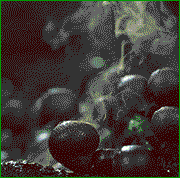|
That’s a giant puffball, calvatia gigantea. As a species they’re good eats but you wanna make sure they’re white all the way through and large enough to eliminate the possibility of being any other species.
|
|
|
|

|
| # ? Apr 25, 2024 13:50 |
|
We have this thing in Scandinavia where Gyromitra esculenta is considered inedible according to the Swedish food safety regulatory body. But it's considered edible according to the Finish equivalent. So Swedish language guides written or sourced from Finland (online/paper versions) are censored when published in Sweden because they're giving dangerous advice basically. Personally I think it's kind of an effort shroom to try and purge of toxins and it doesn't seem worth the hassle.
|
|
|
|
It must taste awfully good for people to be worth going through all the bullshit and risk for it. A few weeks back but we found a huge reef of coral mushrooms at a different park. Just tons of them all over.    And these, uh, aggressively gilled fellows. 
|
|
|
|
Scarodactyl posted:It must taste awfully good for people to be worth going through all the bullshit and risk for it. I had one as a kid. It started out as a brain lump the size of my fist. Once boiled down to be "clean" and then fried in a pan with butter, what was left was basically a piece of black chewing gum and it didn't taste very special.
|
|
|
|
the yeti posted:That’s a giant puffball, calvatia gigantea.
|
|
|
|
   Lactarius sanguifluus Bloody milk cap
|
|
|
|
What the hell those are wild, those bloody gills?! I cant stop looking
|
|
|
|
I can see how it gets the name. That looks disturbingly meaty.
|
|
|
|
And they dye your fingers a nice blood red, too.
|
|
|
|
Nice to meet ya, amanita! You too, stropharia ambigua, or whoever you are... 
|
|
|
|
Several years ago my local woodland was absolutely packed full of birch polypore (Piptoporus betulinus, including many specimens that were significantly bigger than my face. We harvested a lot of this, dried it up for tea and it lasted us much of the year. Now, we hardly see any. Equally, the small patch of St. George's Mushroom (Calocybe gambosa) is 99% less spectacular than it used to be. In fact now one of the most common finds is hoof fungus (Fomes fomentarius) which 10 years ago was considered incredibly rare around here. I often find myself thinking 'wow what a wet summer we've had, that'll be good for mushrooms' but it doesn't seem to have turned out that way. Are there any predictive factors we can look out for to predict the abundance of fungi, or is the answer a predictably 'no, there's a million different things so we'll never be able to tell'?
|
|
|
|
I think fungi are like dogs and just sort of do things arbitrarily.
|
|
|
|
Wild populations tends to be kind of cyclic, so maybe there's a gap year involved? Like, you only get those really giant population explosions when one or more really good years follow on each other.
|
|
|
|
It might be similar to oaks coordinating to do a mast year where they all produce a ton of acorns followed by less productive years. It prevents the population of things that eat them from being sustained at high enough levels that they just eat all the mushrooms before they put off spores.
|
|
|
|
Scarodactyl posted:It might be similar to oaks coordinating to do a mast year where they all produce a ton of acorns followed by less productive years. It prevents the population of things that eat them from being sustained at high enough levels that they just eat all the mushrooms before they put off spores. Knowing fungi I wouldn't put this past them one bit. They are, after all, the real internet.
|
|
|
|
crazyvanman posted:Knowing fungi I wouldn't put this past them one bit. They are, after all, the real internet. a series of tubes
|
|
|
|
Gooch181 posted:
That's a child's foam soccer ball which has seen the test of time.
|
|
|
|
crazyvanman posted:Knowing fungi I wouldn't put this past them one bit. They are, after all, the real internet.
|
|
|
|
Cardiovorax posted:I think in plants it's pheromone-based, so it's technically more like free fungal wifi. Although the heavy lifting and long distance information carrying is done by the mycelium underground. So the interaction with plants and their pheromones is indeed the local wifi connection. From Paul Stamets: quote:I have long proposed that mycelia are the earth’s “natural Internet.” I’ve gotten some flak for this, but recently scientists in Great Britain have published papers about the “architecture” of a mycelium — how it’s organized. They focused on the nodes of crossing, which are the branchings that allow the mycelium, when there is a breakage or an infection, to choose an alternate route and regrow. There’s no one specific point on the network that can shut the whole operation down. These nodes of crossing, those scientists found, conform to the same mathematical optimization curves that computer scientists have developed to optimize the Internet. Or, rather, I should say that the Internet conforms to the same optimization curves as the mycelium, since the mycelium came first.
|
|
|
|
If you find that kind of thing interesting, I think you might also find the studies interesting that employed slime molds to optimize subway line networks. The slime molds completely organically arrived at the same interconnected shape as real-world optimized tube networks when exposed to a configuration of rolled oats placed as the 'stations' of the network.
|
|
|
|
Cardiovorax posted:If you find that kind of thing interesting, I think you might also find the studies interesting that employed slime molds to optimize subway line networks. The slime molds completely organically arrived at the same interconnected shape as real-world optimized tube networks when exposed to a configuration of rolled oats placed as the 'stations' of the network. I've seen that! Blew my mind. I think I read about it in Mycelium Running. If you were to hear his ideas about mycology out of context you might think they were a bit woo woo, but I fully believe that mushrooms rule the world. Just because I'm conscious that I am not providing any primary mushroom content and this is 'The Great Outdoors', another super cool feature of local fungi are 'wood ear' (Auricularia auricula-judae - the common name may have moved with the times but seems we're still stuck with the anti-Semitic Latin version?!). I know they're really common but it never ceases to amaze me how they change appearance with the weather. I once went on a very disappointing walk with a friend to show him how all the dead elder wood in the local area. I say disappointing because, it having been fairly dry, they were barely visible from a distance and even up close looked like dead shriveled black things. He travelled home the next day and it subsequently poured with rain. I went back to the same place and it was like a sea of the freshest, pale brown ears sticking out of every bare inch of dead elder branch. Of course I later learnt, to my even greater astonishment, that you can still harvest them however dry they are and they magically reform again once soaked in water.
|
|
|
|
crazyvanman posted:Are there any predictive factors we can look out for to predict the abundance of fungi, or is the answer a predictably 'no, there's a million different things so we'll never be able to tell'? Real answer: Who the gently caress knows? I have morel spots that put up 1-2 for 10 years in a row all of a sudden put up 10 gallons of mushrooms. The joy of the hobby is the exploration. You're never sure what you're going to find. That being said, 90% of the mushrooms are found by 10% of the people. You start to pick up on patterns the more you focus on a species. Having a diverse pool of species you target means you can target the one that's abundant in a given year/season/week/day. My biggest tip: Things in nature always happen in roughly the same order. If you're tuned into the seasons you know when to look for certain species. The exact time can vary by months, but the chronological order of biological happenings is the same year after year. You can go up/down in elevation or north/south to move forward or backward in that chronological order on a given day. Target places that got rain recently and are primed in the ecological order of things to have your target species show up. Dik Hz fucked around with this message at 15:51 on Jan 15, 2021 |
|
|
|
Dik Hz posted:Man, if you ever figure this out, you'll be rich. Phenology, right? This is something I'm really interested in but by no means know a lot about. It's also one of the scary effects of climate change - that as processes get disrupted or removed, that has knock on effects for other species that can no longer react to the thing they are used to reacting to.
|
|
|
|
crazyvanman posted:Phenology, right?
|
|
|
|
crazyvanman posted:Phenology, right? This is something I'm really interested in but by no means know a lot about. It's also one of the scary effects of climate change - that as processes get disrupted or removed, that has knock on effects for other species that can no longer react to the thing they are used to reacting to. To anyone paying attention to nature, this has been going on for decades. The growing season for corn where I grew up is 6 weeks longer now than it was 35 years ago. Some of that is due to hardier strains, but most of it is dictated by climate.
|
|
|
|

|
|
|
|
Does anyone listen to mushroom podcasts? I've just found this, and only listened to one episode, but I enjoyed it: https://www.welcometomushroomhour.com/blogs/podcasts Also regarding the phenology chat above, it's a topic I'm super-interested in so if anyone's got any suggestions for reading I'd be up for it. Or we can just discuss observations.
|
|
|
|
crazyvanman posted:Does anyone listen to mushroom podcasts? I've just found this, and only listened to one episode, but I enjoyed it: https://www.welcometomushroomhour.com/blogs/podcasts Through the Seasons by Jim Gilbert is another one I like about where I grew up. Also, a lot of foraging books (my fave: Stalking the Wild Asparagus by Euell Gibbons) have a ton of phenology info in them.
|
|
|
|
crazyvanman posted:Does anyone listen to mushroom podcasts? I've just found this, and only listened to one episode, but I enjoyed it: https://www.welcometomushroomhour.com/blogs/podcasts Not a podcast but the learn your land YouTube videos adam haritan does are really nice and easy to understand
|
|
|
|
Dik Hz posted:A sand hill county almanac by Aldo Leopold is the go to for me. I grew up in a similar biome and he really captures the changing of the seasons in that book. Can you review Stalking the Wild Asparagus for me? It seemes like very much my jam
|
|
|
|
Tias posted:Can you review Stalking the Wild Asparagus for me? It seemes like very much my jam The real highlight of the book is that the author describes his forays such a way that a complete amateur can envision following in the author's footsteps. It's an excellent "first forage" book. Dik Hz fucked around with this message at 18:21 on Feb 22, 2021 |
|
|
|
I imagine stalking vegetables is very easy. They're not good at running away.
|
|
|
|
Cardiovorax posted:I imagine stalking vegetables is very easy. They're not good at running away.
|
|
|
|
Yeah it’s a great all-purpose inspirational book and is entertaining even if you already know about or have access to information about the plants it covers. I liked it because I grew up with many of the same plants but only learned about foraging later in life after moving away, so it was a great way to get a new perspective on familiar flora. Probably still not going to try eating pokeweed.
|
|
|
|
Cardiovorax posted:I imagine stalking vegetables is very easy. They're not good at running away. They dont run they hide
|
|
|
|
Prop Wash posted:Probably still not going to try eating pokeweed. I understand that people are omnivores and since pokeweed is so hardy of course they're going to keep trying to eat it but we live in modern times. This plant where if you eat a handful of berries you die so the accepted method for cooking it is boiling the hell out of the leafs, throwing away that pot of poisonous water then boiling the hell out of the leafs again then throwing away that pot of poisonous water then settling down for a nice salad seems unnecessarily risky.
|
|
|
|
Relevant Tangent posted:I understand that people are omnivores and since pokeweed is so hardy of course they're going to keep trying to eat it but we live in modern times. This plant where if you eat a handful of berries you die so the accepted method for cooking it is boiling the hell out of the leafs, throwing away that pot of poisonous water then boiling the hell out of the leafs again then throwing away that pot of poisonous water then settling down for a nice salad seems unnecessarily risky.
|
|
|
|
Stinging nettles are perfectly edible once you boil them, which completely denatures the irritant their hairs contain. It's a fairly popular type of herbal tea where I live, you can buy it in most grocery stores.
|
|
|
|
Nettle pesto too, it's really good.
|
|
|
|

|
| # ? Apr 25, 2024 13:50 |
|
Speaking of boiling and discarding the water, any of y’all eat amanita muscaria? It’s a constant topic of debate in all my mushie groups— some folks feel like their ease of positive ID + clear process for safe prep make them an ideal beginner’s pick, while others insist that you can mess up the boiling process too easily. I live in the PNW so I just haven’t bothered to eat anything besides chants, morels, oysters, and shaggy parasols myself
|
|
|


























